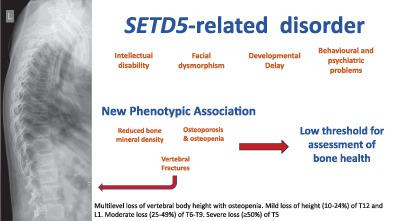Clinical Genetics ( IF 3.5 ) Pub Date : 2021-06-24 , DOI: 10.1111/cge.14014 Elizabeth Anderson 1 , Zena Lam 2 , Paul Arundel 3 , Michael Parker 4 , Meena Balasubramanian 3, 4, 5

|
Patients with SETD5-related disorder have variable features of intellectual disability (ID), facial dysmorphism, cardiac and skeletal abnormalities, behavioural problems, and short stature.1 We present two patients with pathogenic SETD5 variants and bone fragility, a new associated phenotype. Both patients were recruited via the deciphering developmental disorders (DDD) study (https://www.deciphergenomics.org/) and informed consent for publication was obtained.
Patient 1: 14-year-old male (see Figure 1) with a pathogenic heterozygous c.1381_1388del, (p.Asn461fs) variant in exon 12 of SETD5.2 At 13 years of age, he was found to have multiple thoracic vertebral crush fractures following a minor fall from a swing at a low height onto his buttocks with resulting back pain which was investigated 10 days later. Radiographs showed multiple wedging of his thoracic spine both new and old which was confirmed on MRI-spine imaging. A transiliac bone biopsy showed mild osteopenia with increased cortical resorption and formation. Treatment with zoledronic acid (dose escalation over 9 months up to 0.05 mg/kg 6 monthly) resulted in improvement in DXA-measured bone parameters after 10 months: L2-4 and total body less head (TBLH) BMD increased by 13% and 7%, respectively; corresponding Z-scores increased from −2.8 to −2.7 and from −1.7 to −1.5, respectively.

Patient 2: 10-year-old female (see Figure 1) in whom there were concerns with feeding difficulties, global developmental delay and poor weight gain in the first year of life. Her mother has mild–moderate ID with no bone fragility. She was found to carry a maternally inherited pathogenic nonsense variant in SETD5 c.3214C > T (p.Arg1072*).
At 8 years of age, the patient developed acute lower back pain following a forward fall onto laminate kitchen flooring. Spinal radiographs identified wedging of T11 and L1 (10%–24%) and mild wedging of multiple other thoracic vertebrae (<10% anterior height loss). Treatment with zoledronic acid (dose escalation over 10 months up to 0.05 mg/kg 6 monthly) resulted in improvements in vertebral shapes, and in DXA-measured bone parameters after 20 months: L2-4 and TBLH MD increased by 14% and 11%, respectively; although corresponding Z-scores changed a little, from −1.4 to −1.5 and from −2.1 to −2.0, respectively.
Bone-related biochemistry in both patients was normal (serum calcium, phosphate, alkaline phosphatase and 25-hydroxyvitamin D concentrations). There was no significant history of medication use impacting bone health or evidence of a connective tissue disorder in either patient.
Patients reported here have features in keeping with a SETD5-related disorder. The key feature that has not previously been highlighted is bone fragility in the absence of a relevant family history of fractures. This suggests previously unrecognised, phenotypic association with SETD5-related disorder especially in the context of trio exome sequencing which has not identified any other cause for bone fragility.
SETD5 is a ubiquitously expressed, highly conserved histone methyltransferase.3 There is evidence highlighting the important role of histone methyltransferase activity in osteogenic differentiation of mesenchymal stem cells (MSC).4 SET-domain containing histone lysine methyltransferases have been shown to contribute to the balance between osteogenesis and adipogenesis in MSCs and mice with loss of Setd2 causes a propensity for adipogenesis and loss of osteoblasts, thus raising the possibility of other SET-domain containing histone methyltransferases also having an impact on bone density.5
Compression fractures of spine can occur as a result of trauma, osteoporosis and heritable bone fragility conditions such as Osteogenesis Imperfecta (OI). Back pain and kyphosis can be initial presenting features although it may remain a late diagnosis. SETD5-related disorder remains a rare genetic condition; future systematic clinical and radiological phenotyping of these patients will be required to confirm this association. This paper highlights a need for a low threshold for bone health assessment in SETD5. Clinical screening and judicious use of imaging (e.g., lateral spine imaging with DXA) may enable early identification of bone fragility and ensure timely initiation of bone-targeted medication.
中文翻译:

扩大 SETD5 相关疾病的表型并呈现与骨脆性的新关联
SETD5相关疾病患者具有智力障碍 (ID)、面部畸形、心脏和骨骼异常、行为问题和身材矮小等多种特征。1我们介绍了两名具有致病性SETD5变异和骨脆性的患者,这是一种新的相关表型。两名患者都是通过解密发育障碍 (DDD) 研究 (https://www.deciphergenomics.org/) 招募的,并获得了发表的知情同意书。
患者 1:14 岁男性(参见图 1),在SETD5的外显子 12 中具有致病性杂合 c.1381_1388del, (p.Asn461fs) 变异。2个13 岁时,他被发现有多处胸椎挤压骨折,原因是他从低处的秋千上轻微跌落到臀部,导致背部疼痛,10 天后接受调查。X 光片显示他的新旧胸椎多处楔形,这在 MRI 脊柱成像中得到证实。经髂骨活检显示轻度骨质减少,皮质吸收和形成增加。用唑来膦酸治疗(9 个月内剂量增加至 0.05 mg/kg,每月 6 次)导致 10 个月后 DXA 测量的骨参数有所改善:L2-4 和全身少头 (TBLH) BMD 分别增加 13% 和 7 %, 分别; 相应的 Z 分数分别从 -2.8 增加到 -2.7 和从 -1.7 增加到 -1.5。

患者 2:10 岁女性(见图 1),她担心喂养困难、整体发育迟缓和出生后第一年体重增加不佳。她的母亲患有轻度至中度智力障碍,没有骨脆性。她被发现在SETD5 c.3214C > T (p.Arg1072*)中携带母系遗传的致病性无义变异。
在 8 岁时,患者向前跌倒在强化厨房地板上后出现急性腰痛。脊柱 X 光片发现 T11 和 L1 楔形 (10%–24%) 和多个其他胸椎的轻度楔形 (<10% 前高度损失)。用唑来膦酸治疗(10 个月内剂量增加至 0.05 mg/kg,每月 6 次)导致椎体形状和 20 个月后 DXA 测量的骨骼参数得到改善:L2-4 和 TBLH MD 增加了 14% 和 11% , 分别; 尽管相应的 Z 分数略有变化,分别从 -1.4 到 -1.5 和从 -2.1 到 -2.0。
两名患者的骨相关生化指标均正常(血清钙、磷酸盐、碱性磷酸酶和 25-羟基维生素 D 浓度)。两位患者都没有影响骨骼健康的药物使用史或结缔组织疾病的证据。
此处报告的患者具有与SETD5相关疾病一致的特征。之前没有强调的关键特征是在没有相关骨折家族史的情况下骨骼脆性。这表明以前未识别的表型与SETD5相关疾病相关,尤其是在尚未确定骨脆性的任何其他原因的三重外显子组测序的背景下。
SETD5是一种普遍表达的、高度保守的组蛋白甲基转移酶。3有证据强调组蛋白甲基转移酶活性在间充质干细胞 (MSC) 的成骨分化中的重要作用。4含有组蛋白赖氨酸甲基转移酶的 SET 结构域已被证明有助于 MSC 中成骨和脂肪生成之间的平衡,而 S etd2缺失的小鼠会导致脂肪生成倾向和成骨细胞丢失,从而增加其他含有组蛋白 SET 结构域的可能性甲基转移酶也对骨密度有影响。5个
外伤、骨质疏松症和成骨不全症 (OI) 等遗传性骨脆性病症可能导致脊柱压缩性骨折。背痛和脊柱后凸可能是最初的表现特征,尽管它可能仍然是晚期诊断。SETD5相关疾病仍然是一种罕见的遗传病;未来需要对这些患者进行系统的临床和放射学表型分析来证实这种关联。本文强调了SETD5中骨骼健康评估的低阈值需求。临床筛查和明智地使用成像(例如,使用 DXA 的侧脊柱成像)可以早期识别骨脆性并确保及时开始骨靶向药物治疗。

























 京公网安备 11010802027423号
京公网安备 11010802027423号